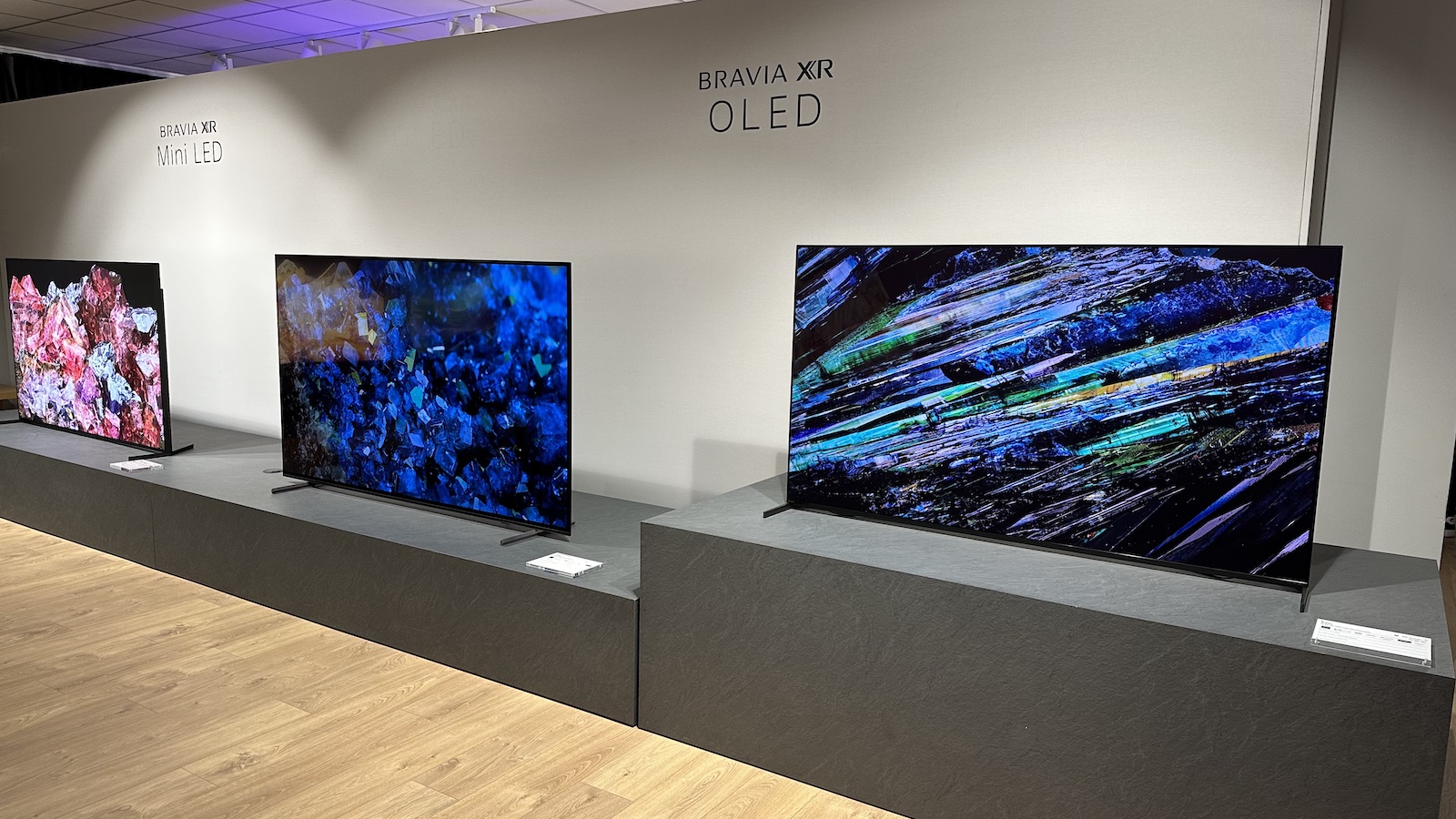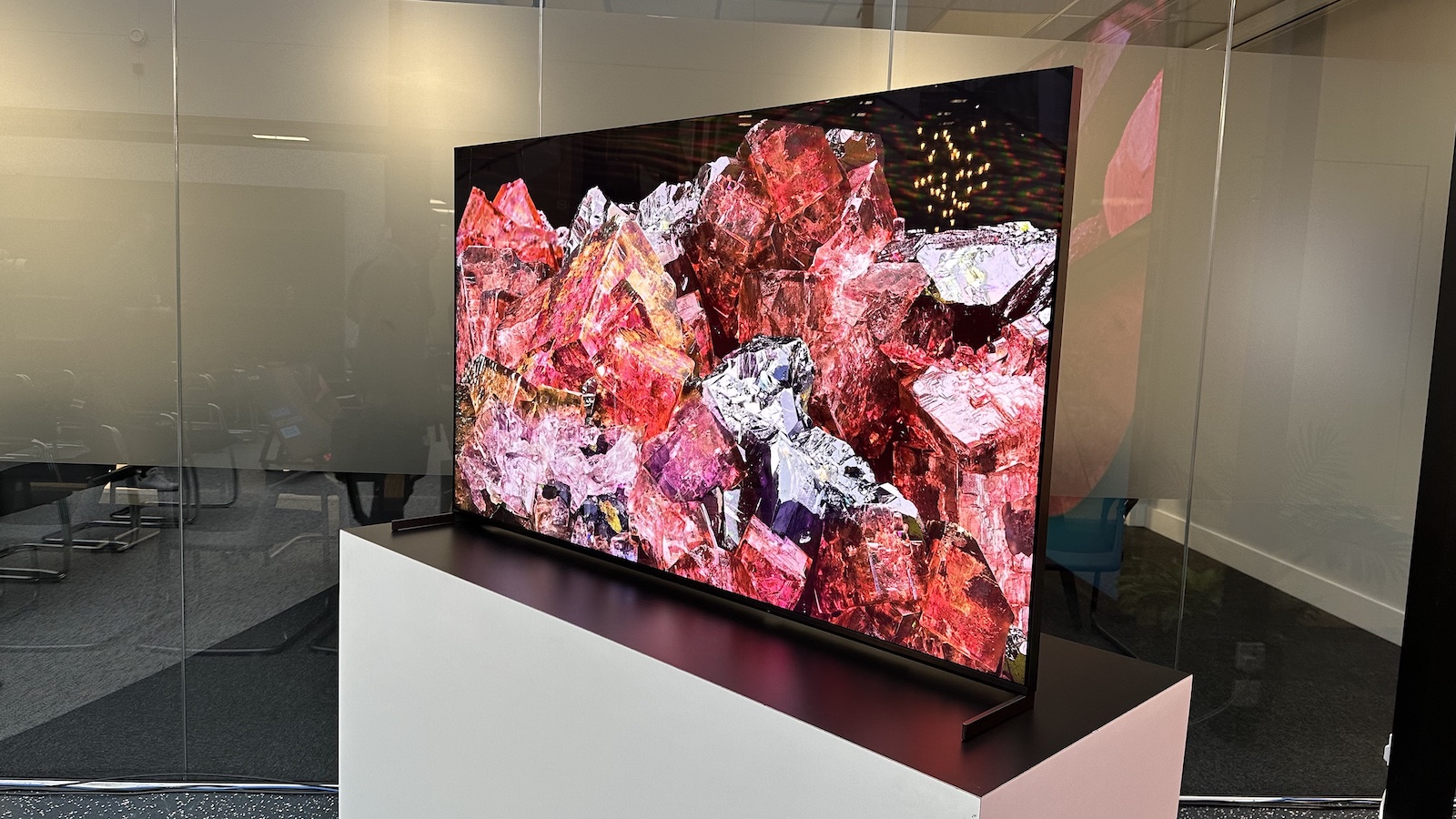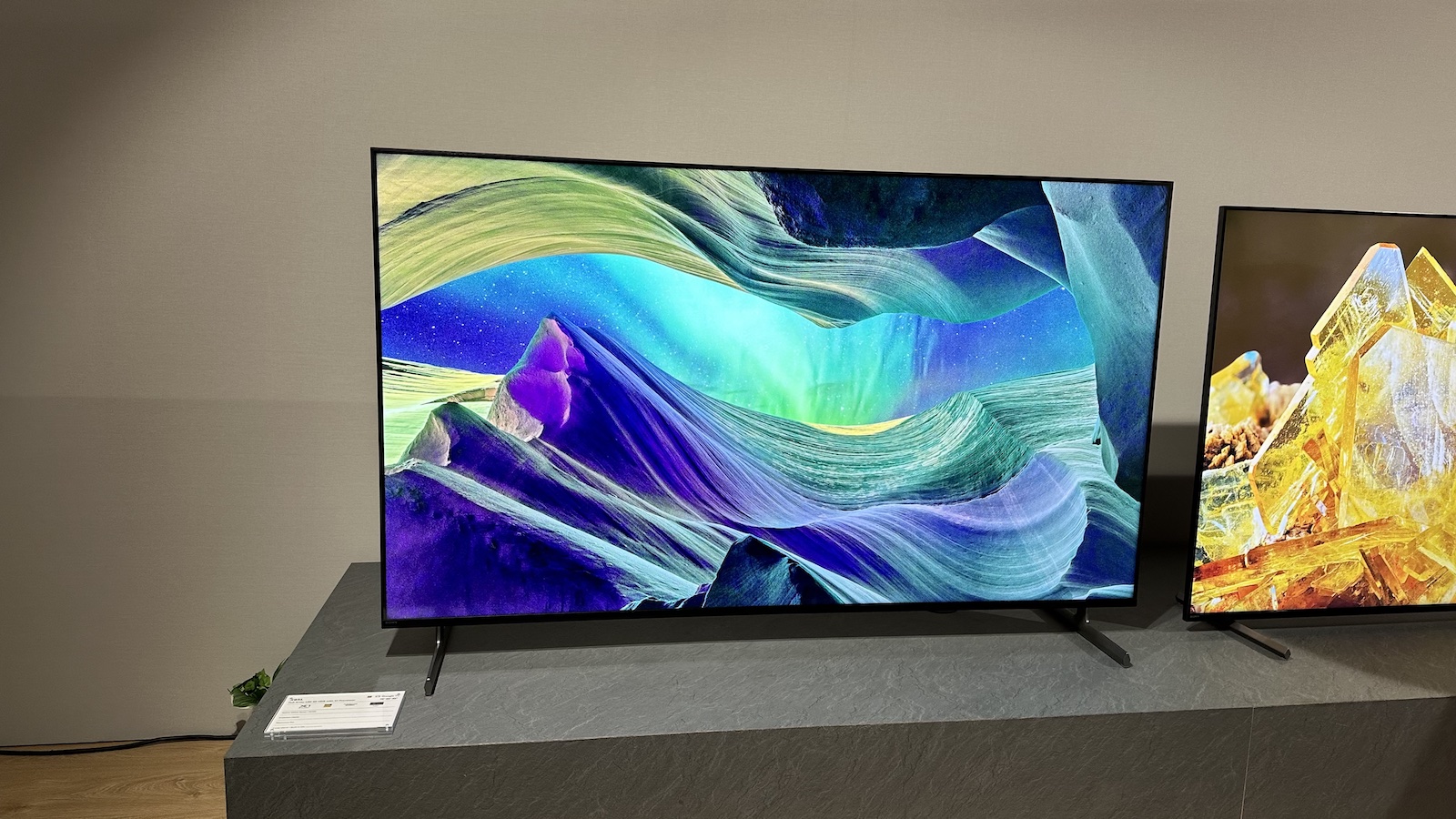Sony announces 2023 TV range, including '200% brighter' A95L QD-OLED
Sony is sticking with QD-OLED over MLA technology

After a surprise non-appearance at CES 2023, Sony has finally lifted the lid on its latest TV range.
At the top of the new range sits the A95L QD-OLED, which is said to be "up to" 200 per cent brighter than the outgoing A95K, and the X95L Mini LED-backlit LCD, which is apparently up to 30% brighter than the already very bright X95K it replaces.
While Sony is, like many other manufacturers, pretty coy about the components its TVs use, it seems fair to assume that the A95L uses the new, second-generation QD-OLED panel from Samsung Display. This is almost certainly the same panel that will feature in the Samsung S95C.
To this, Sony adds its own heat diffusion sheet (aka a heatsink) and thermal analysis, driven by the Cognitive Processor XR. It's the combination of these elements that results in the apparently huge increase in peak brightness. Sony isn't giving out specific peak brightness figures, but it's probably fair to expect the TV to hit 2000+ nits in its most vivid picture mode, and something in the region of 1500 nits in its more natural and authentic presets. As ever, though, we'll be putting these claims to the test when we get the TV into our own labs.
On top of the 55- and 65-inch sizes that the A95K was available in, the A95L will also be available as a 77-inch model.
Other highlights exclusive to the A95L include support for Dolby Vision gaming and Multi View - the latter of which allows you to display one source on one side of the screen and another on the other. The use case given by Sony was playing a game in one window while watching a YouTube tutorial in the other. Unfortunately, the A95L (and its siblings in the 2023 range) still has just two HDMI 2.1 sockets that support 4K/120Hz gaming.
The A95L is also the only TV in Sony's 2023 range that comes bundled with the Bravia CAM camera (it's an optional extra for all other models), which clips to the TV's top edge and unlocks a host of smart features, including video calling, automatic power saving and picture and sound optimisation based on the specific spot in the room that you're sitting in. We weren't entirely convinced by Bravia CAM last year, but we're intrigued to give it another go when we test this year's new models.
The latest hi-fi, home cinema and tech news, reviews, buying advice and deals, direct to your inbox.
Design-wise, the A95K's elegant but huge and impractical stand has been replaced for the A95L by feet that are positioned at the furthest extremes of the TV's bottom edge. Sony calls this a "noiseless" design because it avoids creating reflections on the screen, but the TV having such a wide footprint won't be ideal for everyone. The 77-inch model does allow for the feet to be positioned closer to the centre of the chassis, but that's not an option for the 65- or 55-inch versions. All the sets have a soundbar position, so that the TV can be raised in order to make room for a soundbar.
On the subject of sound, the A95L unsurprisingly features Sony's Acoustic Surface Audio+ technology, which involves actuators that vibrate the whole screen in order to make sound. There's been no mention of any hardware upgrades over the A95K's audio system, which leads us to believe there probably aren't any, but that's no bad thing – the A95K is one of the best-sounding TVs you can currently buy.
X95L Mini LED with more zones and higher brightness

The Yin to the A95L's Yang is the X95L Mini LED set, which Sony essentially sees as a joint-flagship model – though the fact that the A95L gets support for Dolby Vision gaming and Multi View while the X95L does not, and is also the only model that comes bundled with the Bravia CAM, suggests that this flagship status isn't truly equal.
That isn't to say that the X95L hasn't been equally lavished with attention by Sony. The key points here are that the number of dimming zones has been increased over the X95K, and peak brightness has been increased by "up to" 30%. Sony won't put more specific figures on either of these upgrades, but in a brief demo it seemed clear to me that the X95L was a substantial improvement in terms of punch, shadow detail and contrast, with very little in the way of blooming, particularly when viewing the screen head-on. As ever, a manufacturer-led demo can never be fully trusted, and we'll test these elements fully ourselves just as soon as we can get the X95L into our test labs.
The X95L will be available in 65-, 75- and 85-inch sizes, and all will have feet that can be positioned at the edges, closer to the centre or in a raised, soundbar-friendly setup.
As many know, a backlit LCD panel can't be vibrated the way that an OLED one can, but the X95L instead features frame tweeters similar to those found on last year's Z9K 8K model. These allow for the sound to appear as if it's coming directly from the screen.
For gaming, 4K/120Hz, VRR and ALLM are all supported, but Dolby Vision gaming is not, which is a real shame. And, as mentioned, none of the TVs have more than two HDMI 2.1 sockets, and we anticipate that one of these will still be the ARC/eARC port that many will need to use in order to connect a soundbar or other sound system.
Step-down A80L OLED model in 83 inches – but no 'small' OLEDs

The A80K 'standard' OLED is also getting a replacement in the form of the A80L, which will be available in a new 83-inch size as well as the 55-, 65- and 77-inch versions of before. In truth, Sony doesn't appear to be making huge claims about this one, suggesting that it's not hugely different from the model it replaces. That would tally with LG's approach this year, which involves a huge step-up for the flagship model (the G3) but very few obvious upgrades to the step-down set (the C3). Of course, the A80L will benefit from some range-wide upgrades, which I'll get to below.
One disappointment with Sony's 2023 TV range is that it's lacking new 42-inch and 48-inch OLED models. The company says it's keeping 2022's A90K model in its range instead, but that's an expensive TV. It's a real shame that the company hasn't instead produced the A80K in smaller sizes that could compete on price with the smaller versions of LG's C3.
More LCD models

Below the above sets sit the X90L, X85L, X80L and X75WL LCD models.
The 90-series has long been one of Sony's most popular, and the company is saying the new X90L is a big step up in performance over the X90K it replaces. This one hasn't been upgraded to Mini LED, but its full-array LED backlight does feature more dimming zones than its predecessor, apparently resulting in better contrast and less blooming.
Launching in 55-, 65-, 75- and 85-inch sizes, as well as a new 98-inch version, the X90L could be a big seller if Sony gets the pricing right.
The X85L is another full-array LED model, albeit one that's a little less bright and has fewer dimming zones. It also has a more basic design and a downgrade of processor from the Cognitive XR Processor of the X90L (and above) to the X1. It will still support 4K/120Hz, ALLM and VRR, though, and will be available in 55-, 65- and 77-inch sizes.
Stepping down to the X80L, we finally get to Sony's first 'small' TVs of 2023. This model will be available in 43-, 50-, 55-, 65-, 75- and 85-inch sizes, and features an edge LED backlight. This is a 60Hz TV with no support for 4K/120Hz or VRR. This means it likely won't be a good choice for next-generation PS5 and Xbox Series X/S gamers.
Finally, we have the X75WL, which will be available in the same sizes as the X80L, with the exception of the 85-inch model. There's a step-down in the processor to a more basic version of the X1 here, and it loses the X80L's Triluminous designation.
Game Menu, Google TV and Bravia Core
There are a few cool features not previously mentioned that feature across the whole Bravia and Bravia XR range for 2023.
For starters, Sony is finally adding a dedicated Game Menu that allows for the quick adjustment of game-related settings while playing. We've seen this from most other brands already, but one of the interesting features of Sony's implementation is an option to reduce the size of the window on which the game is being displayed. Why would you want to do that? Competitive gamers often like to play on relatively small screens that require less eye movement so that action can be responded to more quickly. This feature would allow them to watch movies and TV shows in full screen, but reduce the size of the image for hardcore gaming. The size of the window can be reduced from 100 per cent right down to 30 per cent and anything in between.
All of the new models discussed are, predictably, Google TVs, but all models from the X80L upwards have microphones integrated into their chassis, so they can be controlled entirely hands-free.
It's also finally worth mentioning Bravia Core, Sony's exclusive streaming service that delivers movies in far higher bit rates than are available from the likes of Netflix, Disney+ et al. This continues into 2023, and all of the models mentioned come with credits that can be used for purchasing premium films. You get 10 credits and 24 months of unlimited streaming with the A95L, A80L, X95L and X90L, and 5 credits plus 12 months of unlimited streaming with the X85L, X80L and X75WL.
Sony says that pricing and release dates for its new TVs will be announced "later in 2023". We'll publish that information as soon as we have it and stay tuned for our full reviews.
MORE:
Here are the best TVs you can buy right now
How will Sony's A95L QD-OLED fare against the Samsung S95C
And don't forget the new LG G3
Tom Parsons has been writing about TV, AV and hi-fi products (not to mention plenty of other 'gadgets' and even cars) for over 15 years. He began his career as What Hi-Fi?'s Staff Writer and is now the TV and AV Editor. In between, he worked as Reviews Editor and then Deputy Editor at Stuff, and over the years has had his work featured in publications such as T3, The Telegraph and Louder. He's also appeared on BBC News, BBC World Service, BBC Radio 4 and Sky Swipe. In his spare time Tom is a runner and gamer.

